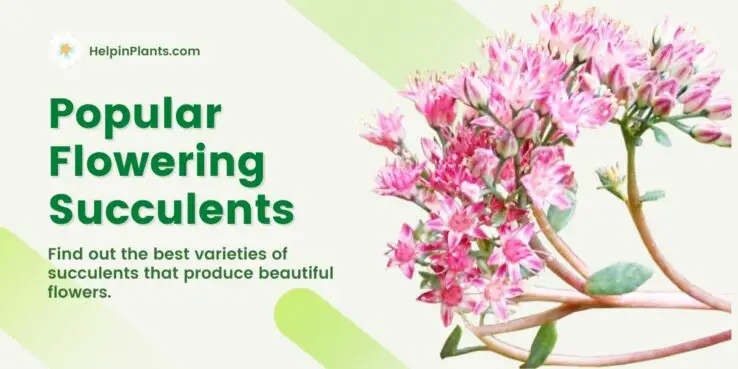
20+ Popular Flowering Succulents
Succulents are one of the most popular plants to grow because they're so easy to care for. They require very little water and sunlight, which means you don't have to do much at all!
There is a huge variety of different types of succulent plants that produce flowers. These blooming succulents will give your indoor environment another layer of delicate beauty.
Here we'll show you over 20 popular flowering succulent varieties along with their best qualities-so you can pick whichever one strikes your fancy!
What are succulent plants
A succulent plant is a water-storing, slow-growing plant with fleshy leaves. Succulents are referred to as sedums and they’re used as a groundcover or as an ornamental accent for your indoor garden or outdoor landscaping. They come in many varieties from those with beautiful leaves to the ones with the most colorful blooms you've ever seen!
In general, succulents look very appealing and soothing due to their ability to store water that other plants need tons of resources. This makes these fellows a perfect fit for planting indoors as they require minimum maintenance.
20+ popular flowering succulents
- Crassula Ovata 'Jade Plant'
- Crassula Rupestris "Baby's Necklace"
- Christmas Cactus Plants
- Crassula Perforata 'String of Buttons'
- Euphorbia Milli
- Kalanchoe (also called Florist Kalanchoe or Flaming Katy)
- Senecio Rowleyanus 'String of Pearls'
- Peanut Cactus
- Ruby Ball Cactus (Also called Moon Cactus, Red Cap Cactus)
- Tacitus Bellus
- Sempervivum Arachnoideum 'Cobweb Hens and Chicks'
- Ice Plant
- Adenium desert rose plant
- Echeveria "Afterglow"
- Aloe Plants
- Aeonium 'Blushing Beauty'
- Graptopetalum Paraguayense 'Ghost Plant'
- Graptosedum 'Francesco Baldi'
- Sedum Rubrotinctum 'Jelly Bean Plant'
- Sedum Treleasei
- Echeveria Doris Taylor
Crassula Ovata 'Jade Plant'
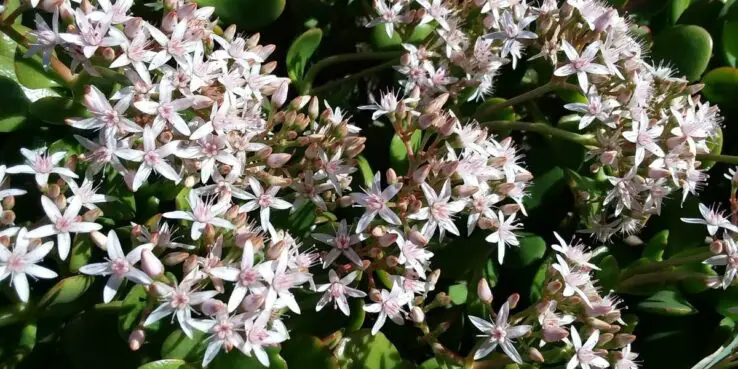
Crassula Ovata “Jade Plant” originated in eastern Asia. It has long, slightly angled leaves that are fleshy. This variety of succulents is also known as the Jade Tree or Money Tree and is sometimes mistaken with other bonsai trees.
Crassula Ovata is an excellent flowering succulent species for both indoor and outdoor use. The bloom of the Jade plant is small but lovely. It has white-pinkish color star-like flowers that you can enjoy in the late winter to early spring.
Don't fertilize or water. As a result, Jade plants begin to blossom because they view this as a period of rest.
Crassula Rupestris "Baby's Necklace"
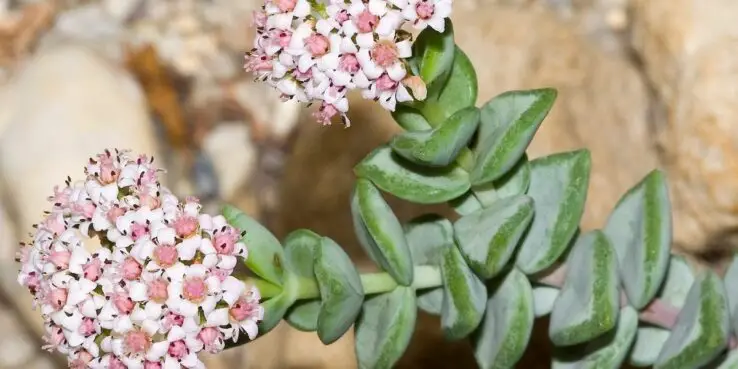
Crassula Rupestris also called “Baby’s Necklace” is native to South Africa. This succulent has a thick stem and like other members of the Crassulaceae family, it contains water-storing leaves.
Crassula Rupestris "Baby's Necklace" blooms in summer with beautiful star-shaped pale pink flowers clusters during late spring to early summer.
Crassula Baby Necklace is an excellent variety of indoor succulents and attracts butterflies. Be aware, though, that it can become quite large with age if it's potted in the right conditions.
Christmas Cactus
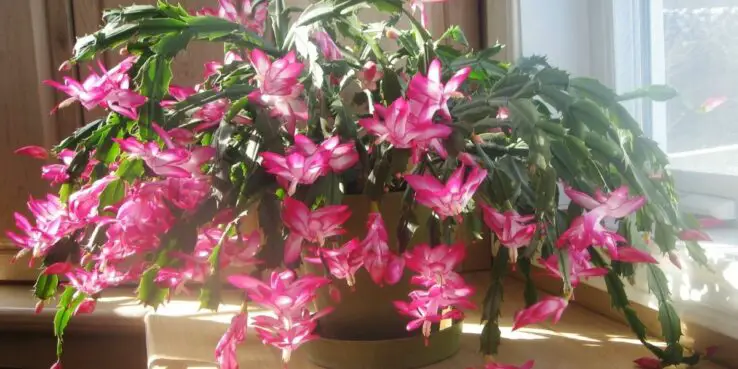
One of the most popular flowering succulents loved almost worldwide, Christmas cacti are known as Thanksgiving & Easter cactus (holiday cactus) due to their blooming times. They're native to Brazil but produce stunning red, white, and pinkish flowers.
These are actually 3 different species, but all are known to be the same.
Christmas cactus is a popular choice for indoor succulents gardeners as it does not require too much effort & time.
Christmas Cactus blooms during fall with slightly pinkish flowers that darken with age. The flower clusters are large and stunning, but not fragrant.
Holiday cacti are excellent plants for any room in your home with medium lighting.
Crassula Perforata 'String of Buttons'

Crassula Perforata is sometimes called the “String of Buttons”, its natural habitat is South Africa. This species has the smallest leaves among the Crassulaceae family which grow in rosettes that are fleshy and jointed.
The String Of Buttons produces small clusters of white and yellow flowers that can be seen during spring to summer.
Don't fertilize or water it until the soil is dry. It's best for indoor use but tolerates temperatures of up to 70 °F (~21 °C).
Euphorbia Milii (also called christ plant)
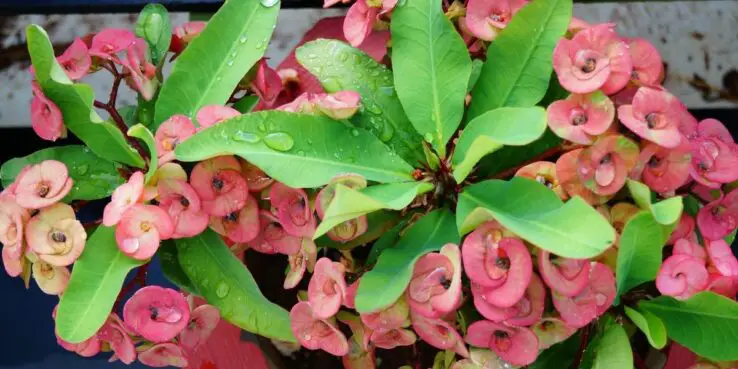
This woody succulent is native to the tropical regions of Africa including South Africa, Tanzania, Kenya, Mozambique & Madagascar. It's also known as the "Crown of Thorn" and "christ plant" due to the thorns and deep red bracts.
Euphorbia Milii produces flowers in varieties of colors, mostly in cream, pink, white, and bi-colors. The blooming season is winter to early spring.
This is one of the most popular flowering succulents, so it's easy to find this for sale in any garden center.
It's great for indoor use as long as you provide bright lighting & fertilize every 2 weeks.
Kalanchoe (also called Flaming Katy)
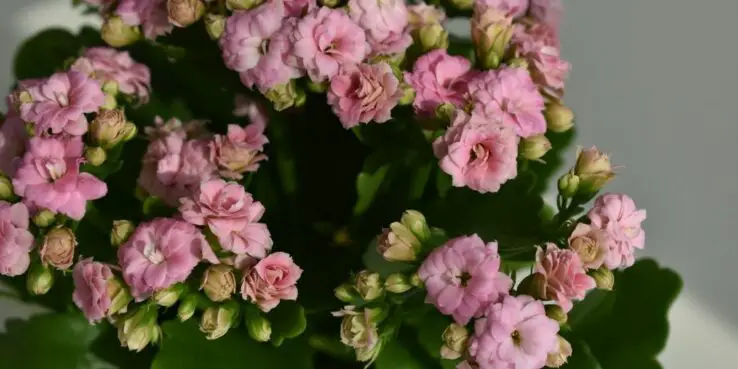
Also known as "Flaming Katy" or "Widow's-thrill" because of its colorful and vibrant blooms. These succulents are tropical plants from Madagascar. They have fleshy leaves with serrated edges.
Their flowering season is late winter to late spring with small clusters of different colors of flowers. They come in red, orange, green, white, pink, lilac, salmon, bi-colored, and yellow flowers varieties. These flowers are attractive to bees & butterflies.
Kalanchoe is a photoperiodic succulent, which means it responds to changes in light. To produce the maximum amount of blooms, provide Kalanchoe with 12 hours of sunshine and 12 hours of total darkness.
Kalanchoe is a genus of about 125 species of tropical. They are among the best flowering succulents. The most beautiful ones with colorful flowers including
- Kalanchoe Blossfeldiana
- Kalanchoe pumila (Flower Dust Plant)
- Pendent Flowered Kalanchoe
- Beach Bells
- Coral Bells
- Kalanchoe Calandiva
- Kalanchoe rhombopilosa var. virdifolia (Pies from Heaven) - You'll love its leaves
Senecio Rowleyanus 'String of Pearls'

Senecio rowleyanus is often known as "string of pearls" is an interesting creeping, perennial, succulent vine with long trailing stems and rosettes of fleshy leaves. Its natural habitat is southwest Africa.
The String of Pearls produces white trumpet-shaped daisy-like flowers studded with long red stamens and bright yellow anthers during summer. It has small greenish buds that open up into tiny white fuzzy flowers paired with string-like leaves along the branch.
Make sure you keep your succulent plant well ventilated as it'll help it grow better. It can withstand a few degrees of frost.
Fertilize regularly & water only when the soil is completely dry. It blooms during spring and prefers bright indoor lighting.
Trailing succulents like String of Pearls are perfect for hanging baskets for home, office, or outdoor as long as you provide it with enough sunlight and warm temperatures.
Peanut Cactus
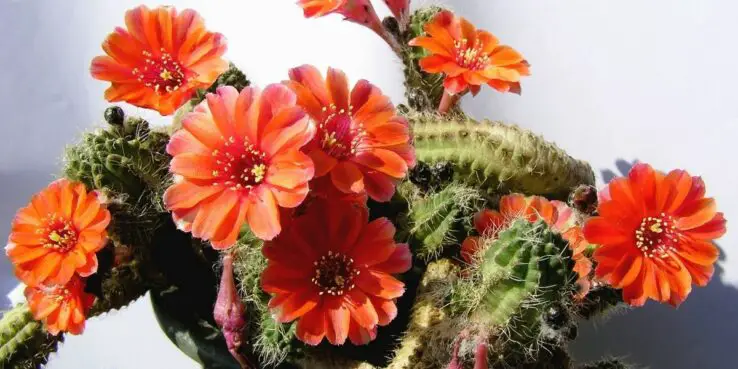
The Peanut Cactus is a low-growing succulent that produces clusters of deep pink flowers on the ends of each branch during fall. Native to South Africa, these species have soft stems which are shaped like peanuts.
It's easy to grow succulent, but it does require bright light indoors & fertilize every 2 weeks. Keep the soil moist and avoid overwatering it.
Ruby Ball Cactus (Also called Moon Cactus, Red Cap Cactus)
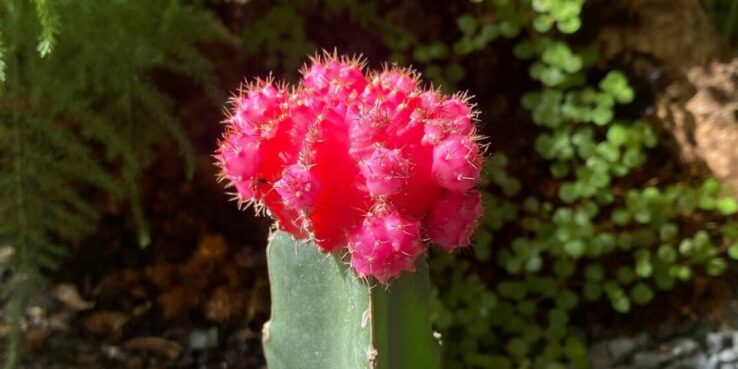
This succulent is almost cylindrically shaped having no spines. Native to Madagascar, this species has a long Year-round blooming season.
Ruby ball cactus (Gymnocalycium mihanovichii) is a grafted specimen that grows on top of other species, often a Hylocereus cactus.
The maximum life of this plant is about up to 5 years, even for the best grafts. Because the moon cactus growth is slower than the base.
But overall, it's easy to grow succulent, and if it is cared for better, then life can be extended or some must be re-grafted on another specimen. It is worth adding to your succulent collection.
Check out the best indoor cacti types.
Tacitus Bellus (Graptopetalum bellum)

Tacitus Bellus, commonly known as Chihuahua Flower, produces red flowers from May to July.
Tacitus Bellus succulent has five dark pink or crimson petals with light-red and white stamens at the center. This succulent flower blooms in late spring to early summer. If given proper care, the flower may endure several weeks.
For flowering, it requires a low temperature in Spring for at least a month. I.e. less than 15 °C (59 °F). It can also survive a short period at even −15 °C (5 °F) if kept totally dry.
Sempervivum Arachnoideum 'Cobweb Hens and Chicks'
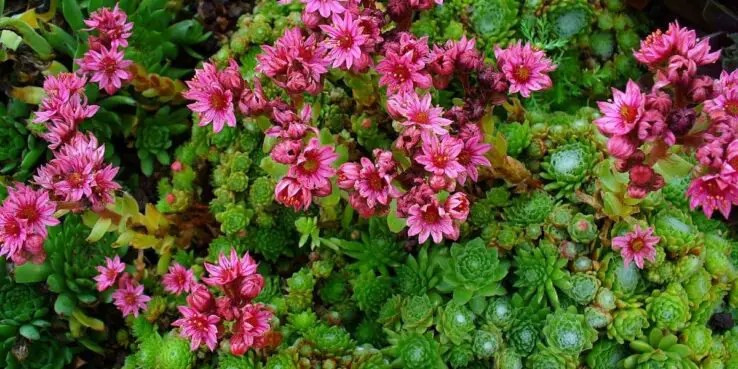
Sempervivum arachnoideum (known as Emily Cobweb house-leek, Hens and Chicks) is a low-growing, mat-forming evergreen perennial succulent plant native to mountains of southern Europe. This species has no stem and forms mats of rosettes that are 1/2" tall x 3" wide.
They do well in a rock garden or container with porous, well-drained soil. They perform best in bright light (to full sun) and depending on the variety can tolerate temperatures below freezing.
Sempervivum arachnoideum Cobweb Hens and Chicks blooms in mid-summer to fall with racemes of pinkish-red flowers.
Emily's flower is star-shaped and has a brilliant pink hue. The bloom occurs throughout the summer, usually towards the end of July. The flower sits on a tall stem and has both male and female components, making it easy to pollinate.
Ice Plant (Delosperma cooperi)
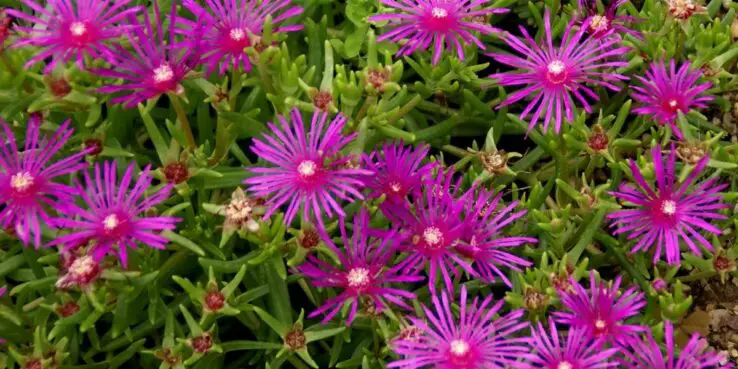
Trailing Iceplant, Delosperma cooperi (Syn. Mesembryanthemum cooperi), hardy ice plants, or pink carpet, are tiny perennial, colonizing plants, native to South Africa that forms a dense lawn with long-lasting blooms.
The fleshy leaves of the Ice plant give them a glistening appearance. These beautiful daisy-like flowering succulents produce a huge number of vermillion, magenta, or pink blooms.
The Ice Plant blooms from spring to summer, depending on the growing conditions. It prefers full sun, but it'll grow well with a partial shade too.
Adenium desert rose plant

The Adenium obesum, also known as the desert rose or Sabi star is a species of flowering plant in the dogbane family, Apocynaceae.
It's been successfully grown all over the world as an ornamental and has been naturalized on some Indian Ocean islands. Native to tropical East Africa south of the Sahel, from Sudan to Mozambique.
These succulent flowers are normally up to 2 to 3 inches – with a shade of red, white, yellow, or pink bract that is often referred to as being "rose-like". The blooms last a long time.
The Adenium desert rose plant does well in full sunlight for most of the day and requires little watering once established.
This plant may be maintained in a container but it grows up to six feet tall. There's also a miniature variety known as desert rose bonsai that blooms at the top and seems like a tiny tree.
Echeveria "Afterglow"
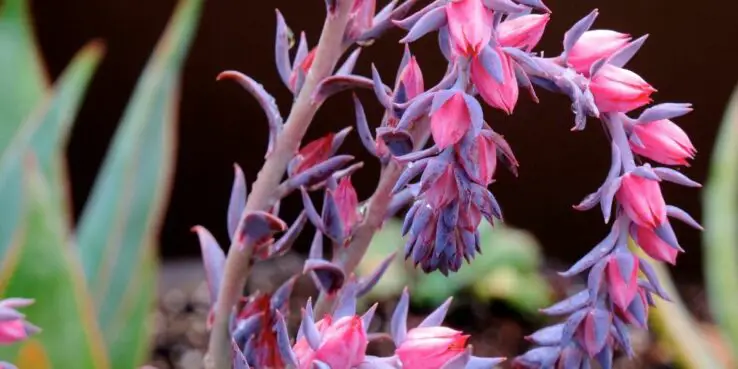
Echeveria 'Afterglow' is a flowering succulent plant and has become one of the most popular houseplants in recent years. It's a gorgeous succulent with broad, powdery pinkish-lavender rosettes and a brighter pink border.
The flowers come in brilliant crimson-orange color during summer, which emerges from beneath the lower leaves or, in some cases, as a terminal spike.
Echeveria Afterglow can be grown indoors and outdoors and it's great for beginners because it doesn't need much care.
Aloe Plants
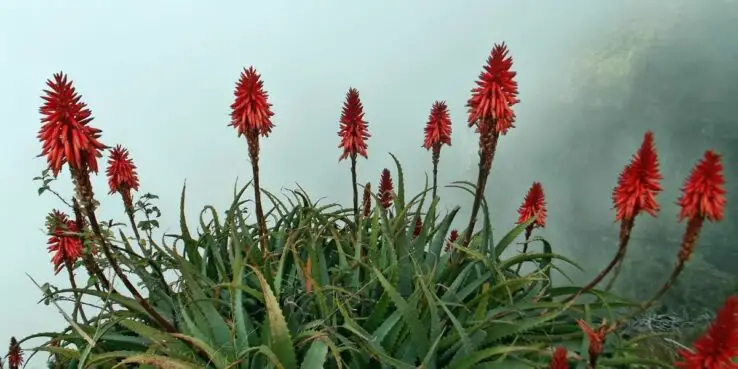
Aloe plants are great for indoor or outdoor use, in part because they can tolerate both extreme heat and cold. They also require very little care once established.
The best thing about the Aloe plant is that it's often used to treat burns because of its natural healing properties.
Aloe flowers come in many colors including yellow, red, or white depending on your variety and they bloom about year-round depending on where you live. It blooms from spring and can last through the summer heat.
Aeonium 'Blushing Beauty'
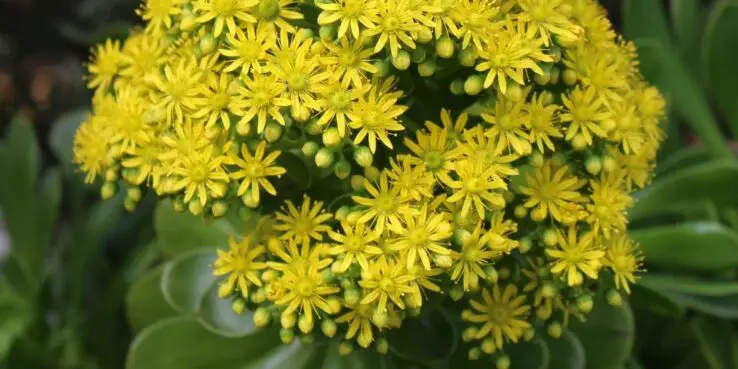
Aeonium 'Blushing Beauty' is a popular choice for indoor use including in window boxes and flower pots. Most cultivars have striking variegated leaves that add interesting textures to the garden or container.
The flowers bloom from the center of the rosette and create lengthy flower stalks, as is the case with most aeoniums. They typically produce pink or yellow flowers that can be quite eye-catching. When it blooms, the mother plant where the flower originates dies. But the offsets will continue to grow until they produce a flower stalk.
Graptopetalum Paraguayense 'Ghost Plant'
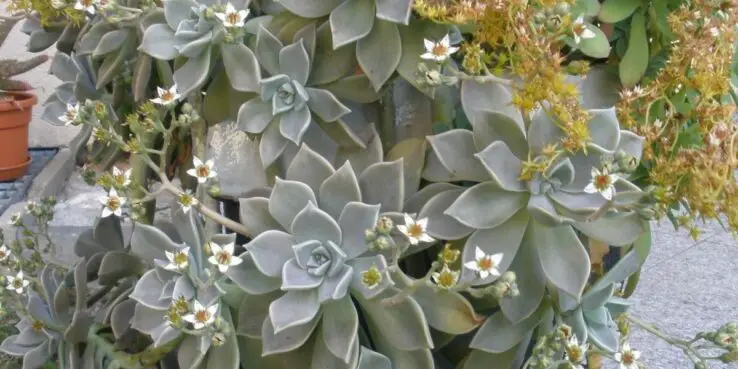
Graptopetalum paraguayense or ghost plant is a perennial succulent native to Mexico. The leaves of the Ghost Plant are thick, flat, and pointed. The pattern of the leaves creates the intricate form of the rosettes.
The ghost plant usually blooms from Spring to Summer. It has beautiful white and yellow star-shaped flowers that go great with pastel colors.
Graptosedum 'Francesco Baldi'

Graptosedum Francesco Baldi is a Graptopetalum paraguayense (Ghost plant) + Sedum pachyphyllum (Green Jelly beans) hybrid.
This plant features light-green leaves with pastel blue, lavender, and pink veins. The flowers are star-shaped and white or yellow in color.
The Francesco Baldi Graptosedum (Darley Sunshine) blooms from early spring to late summer.
Sedum Rubrotinctum 'Jelly Bean Plant' (Blue Green)

Sedum rubrotinctum 'Jelly Bean Plant,' native to Mexico, produces small plump bean-shaped green leaves.
When agitated or exposed to more sunshine or harsh winter, the tips change color to a deep crimson. These plants produce cheerful little star-shaped yellow blooms from winter to spring.
Sedum Treleasei
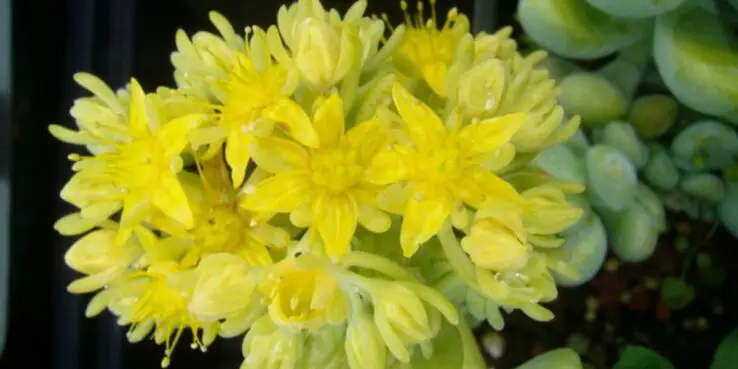
Sedum Treleasei is a variety of Sedum, native to Mexico. It has plump, blue-green leaves that are compacted firmly around its stem. More light exposer may turn the leaves light green to yellowish at the tips.
It produces bright yellow star-shaped flowers from winter to spring.
Echeveria Doris Taylor
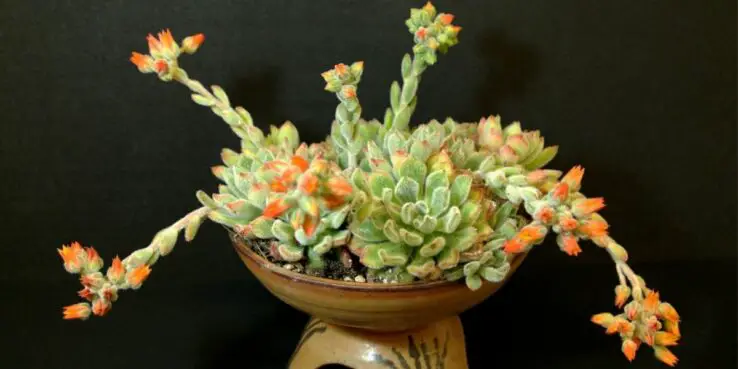
Echeveria Doris Taylor has broad, powdery pinkish-lavender rosettes and a brighter pink border.
The flowers change to a brilliant crimson-orange color during summer, which emerges from beneath the lower leaves or, in some cases, as a terminal spike.
It can be grown indoors and outdoors and it's great for beginners because it doesn't need much care. The actual bloom time is between spring and fall.
Conclusion
Succulents are easy plants to care for because they don't need much water or sunlight. They're great, low-maintenance plants that can be grown indoors or outdoors! But with blooms, these plants look a lot beautiful than usual.
To encourage flowering succulent blooms, you'll want to provide more light and less water than usual.
For best results with your indoor garden of succulents, make sure the soil is well-drained but provides enough nutrients.
For more in-depth info, please check out the caring and growing succulents indoor guide
Frequently Asked Questions
Which succulents die after flowering?
Monocarpic plants are those that bloom once, then die after flowering and setting seeds.
Most aeoniums and sempervivums are among the monocarpic succulents. They produce eye-catching blooms. The bloom stalk comes out of the center of the plant’s rosette. During maturity, the whole plant seems to be transformed into one long flower stalk.
Monocarpic succulents are some of the best flowering succulents, as their flowers are vibrant and hard to miss. They stay in bloom for weeks and even months. But the plant dies after blooming once.
Agave Vilmoriniana, Kalanchoe Lucia, Aechmea Blanchetiana, and Agave Victoriana are monocarpic plants that flower once and die.
When to trim a flowering succulent?
Succulents require trimming to produce the best results. Succulents should be trimmed early in the spring before they start blooming. This helps a plant give more energy to the flower, resulting in stronger, healthier, and beautiful flowers.
Succulents can also be trimmed throughout the fall or winter when their blooming generally slows down and they enter a dormant stage. Remove extra leaves from the succulent plant during this period.
What stimulates succulents to bloom?
Light: Lots of sunlight during the day and complete darkness at night encourages flowering in succulents. When caring for indoor plants, place them near a window for 10-12 hours per day. Then move it somewhere darker such as in the basement where there is complete darkness.
Water: During blooming, decrease watering and stop fertilizing the succulents as this encourages foliage growth rather than flowers.
Blooming: Most succulents bloom in spring to summertime; some succulents bloom in fall. Know the variety and its usual blooming cycle.
Note: Not all succulents will bloom or produce bloom stalks.
What to do with flowering succulents?
Succulents bloom require special care, but we can take steps to make the bloom last longer. Most succulents are picky when they flower, i.e. you must give optimum care and temperature to encourage blossoming.
Flowering succulents are attractive to insects, such as aphids that can damage the bloom and the plant. Spray the succulent with an organic herbicide or a solution of water and alcohol mixed horticulture soap.
Most succulents lift their flowers high into the air on arching stems (bloom stalks), so the insects locate them easily.
How to care for blooming succulents?
If you want your succulents to flower, you'll need to take care of it a bit more to maintain and encourage the flowering.
Light, Water, Fertilizer, and Soil are some factors that you'll need to adjust while growing succulents and encourage your succulent blooms.
How much light is required for succulents to blooming?
Usually, succulents prefer to be exposed to sunshine, and most thrive in full direct sunlight or partial light. So keep them near an eastern or southern window. But if you're in a hot location, place the succulent in the shade to avoid unwanted flower burn-out.
Depending on your succulent species type, provide enough sunlight during the day, and keep it in total darkness during the night.
How often to Water flowering succulents?
Succulents store water in their body, as this is how a drought-tolerant plant survive. But watering too much to flowering succulents may lead to root rot and cause their flowers to wither and fall off.
So during blooming, decrease watering, as this will trigger its blooming growth. Always water when the soil is dried out. I.e. it is usually once every 2 weeks depending on your environment.
Should you fertilize when succulent flowers?
Usually, it is better to avoid fertilizing (especially in winter dormancy season or whatever dormant season for your plant is). But when it’s flowering, you can add little fertilizer, containing more phosphorous. But if your soil is nutrients rich, you can avoid it.
What Soil should be used to better bloom succulents?
Succulents love to have airy and well-draining soil as it doesn't like damp clays. At the same time, it should be able to provide enough nutrients to the plant.

